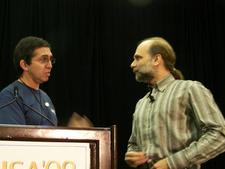USENIX LISA: Security Theater Plays a Role - Bruce Schneier's Keynote
The opening keynote Thursday of the USENIX LISA conference in San Diego was by author and security expert Bruce Schneier. In his opinion "perceived security" should be an aspect of all security implementation.
The large conference room was packed at Schneier's presentation, "Reconceptualizing Security." In one of his first slides, he pointed out that security has always been one of the basic human instincts by showing the part of the brain known as the amygdala where the emotion of fear (and its opposite, security) is seated. Schneier joked that "the newer part of the human brain responsible for heuristics is still in beta." He undermined the discrepancy between subjective feelings and provable facts with a few examples. Deviating from his slides and presentation material, he relied mainly on his words and gestures. "Security is at one time feeling and reality," according to his thesis, "You can feel safe without actually being safe, and you can feel unsafe for no apparent reason."
Schneier applied his thesis to a phenomenon he called "security theater." As an example he used the safety screw cap, designed to quell any fear that the content of the bottle might have been tampered with. He could think of at least ten ways that the content could be compromised, mentioning a syringe for one. Nevertheless, tamper-proof bottles provide an objective sense of security, which proved a saving grace for the medication industry after some well known poisoning incidents. Schneier felt that "as technicians, we kid ourselves that the security for which we're responsible is reliabable. That isn't true. We forget that humans play a major role."
Ignoring the emotional part of security is wrong in Schneier's judgment, and he advises technicians to incorporate the "security theater" concept in their work. Responding to a question about statistics, he suggested that they have little effect: "People who know statistics think they work better, but they don't." According to him, security models should adhere closely to reality, while recognizing that reality is mutable. His conclusion: "It's only when the feeling and the reality of security converge that we have real security."
Subscribe to our Linux Newsletters
Find Linux and Open Source Jobs
Subscribe to our ADMIN Newsletters
Support Our Work
Linux Magazine content is made possible with support from readers like you. Please consider contributing when you’ve found an article to be beneficial.

News
-
Gnome’s Dash to Panel Extension Gets a Massive Update
If you're a fan of the Gnome Dash to Panel extension, you'll be thrilled to hear that a new version has been released with a dock mode.
-
Blender App Makes it to the Big Screen
The animated film "Flow" won the Oscar for Best Animated Feature at the 97th Academy Awards held on March 2, 2025 and Blender was a part of it.
-
Linux Mint Retools the Cinnamon App Launcher
The developers of Linux Mint are working on an improved Cinnamon App Launcher with a better, more accessible UI.
-
New Linux Tool for Security Issues
Seal Security is launching a new solution to automate fixing Linux vulnerabilities.
-
Ubuntu 25.04 Coming Soon
Ubuntu 25.04 (Plucky Puffin) has been given an April release date with many notable updates.
-
Gnome Developers Consider Dropping RPM Support
In a move that might shock a lot of users, the Gnome development team has proposed the idea of going straight up Flatpak.
-
openSUSE Tumbleweed Ditches AppArmor for SELinux
If you're an openSUSE Tumbleweed user, you can expect a major change to the distribution.
-
Plasma 6.3 Now Available
Plasma desktop v6.3 has a couple of pretty nifty tricks up its sleeve.
-
LibreOffice 25.2 Has Arrived
If you've been hoping for a release that offers more UI customizations, you're in for a treat.
-
TuxCare Has a Big AlmaLinux 9 Announcement in Store
TuxCare announced it has successfully completed a Security Technical Implementation Guide for AlmaLinux OS 9.

